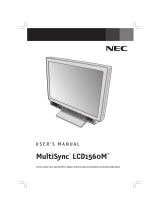
Warning ................................................................................................................................................................ 1
Contents ...............................................................................................................................................................2
Display Setup .......................................................................................................................................................3
Mounting ..............................................................................................................................................................8
Flexible Arm Installation ................................................................................................................................10
Controls ..............................................................................................................................................................12
Recommended Use ...........................................................................................................................................15
Specications.................................................................................................................................................... 17
Features ............................................................................................................................................................ 20
Troubleshooting................................................................................................................................................21
Advanced Menu ................................................................................................................................................22
References .........................................................................................................................................................23
Limited Warranty ............................................................................................................................................ 24
TCO’03 .................................................................................................................................................................25
Manufacturer’s Recycling and Energy Information .............................................................................. 26
Avertissement ............................................................................................................................................... 28
Contenu ............................................................................................................................................................. 29
Conguration de I’afchage ......................................................................................................................... 30
Montage .............................................................................................................................................................35
Installation du bras exible ..........................................................................................................................37
Commandes .......................................................................................................................................................39
Usage recommandé ........................................................................................................................................ 42
Fiche technique ............................................................................................................................................... 45
Fonctions........................................................................................................................................................... 48
Dépannage ........................................................................................................................................................ 49
Menu Advancé ................................................................................................................................................. 50
Références .........................................................................................................................................................51
Garantie limitée ...............................................................................................................................................52
TCO’03 .................................................................................................................................................................53
Informations du fabricant relatives au recylage et aux économies d’énergie ............................... 54
Advertencia .......................................................................................................................................................57
Contenidos ........................................................................................................................................................ 58
Instalación de la pantalla .............................................................................................................................. 59
Montaje ............................................................................................................................................................. 64
Instalación de brazos exibles ..................................................................................................................... 66
Controles ........................................................................................................................................................... 68
Uso recomendado ............................................................................................................................................. 71
Especicaciones ...............................................................................................................................................73
Características .................................................................................................................................................76
Solución de problemas ....................................................................................................................................77
Menú avanzado .................................................................................................................................................78
Referencias ........................................................................................................................................................79
Garantía limitada ............................................................................................................................................80
TCO’03 .................................................................................................................................................................81
Información del fabricante sobre reciclado y energía ........................................................................... 82
Index






















